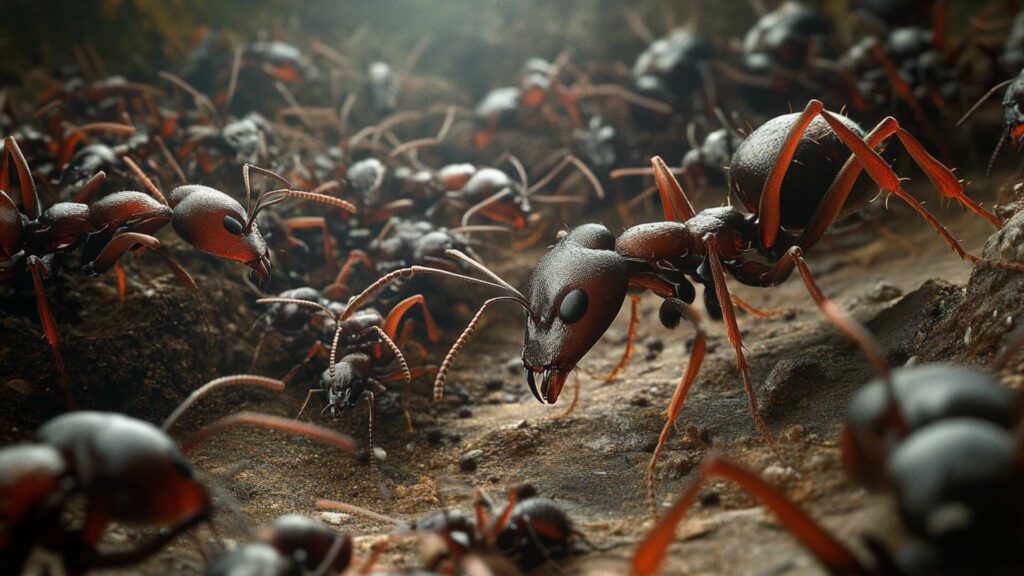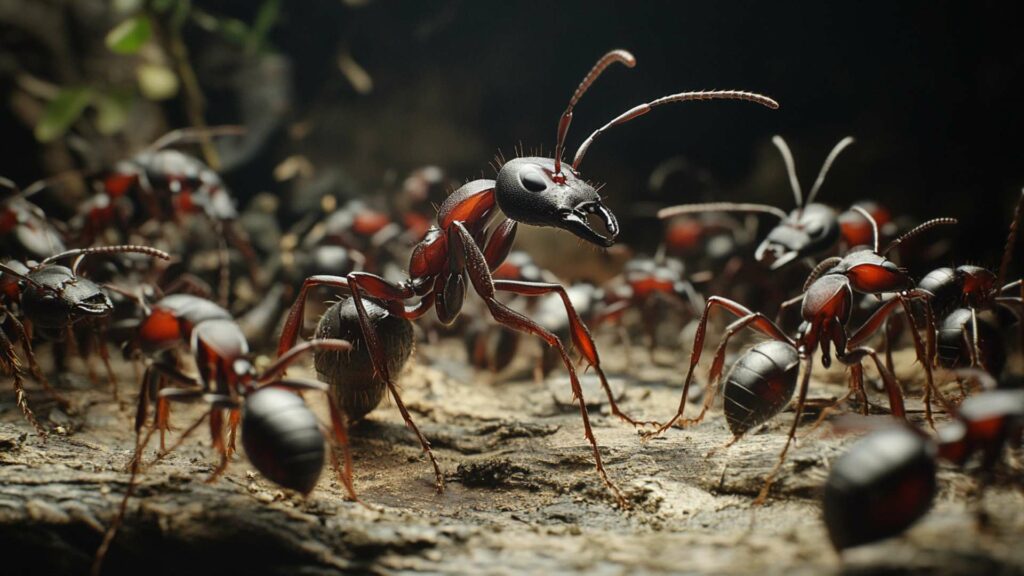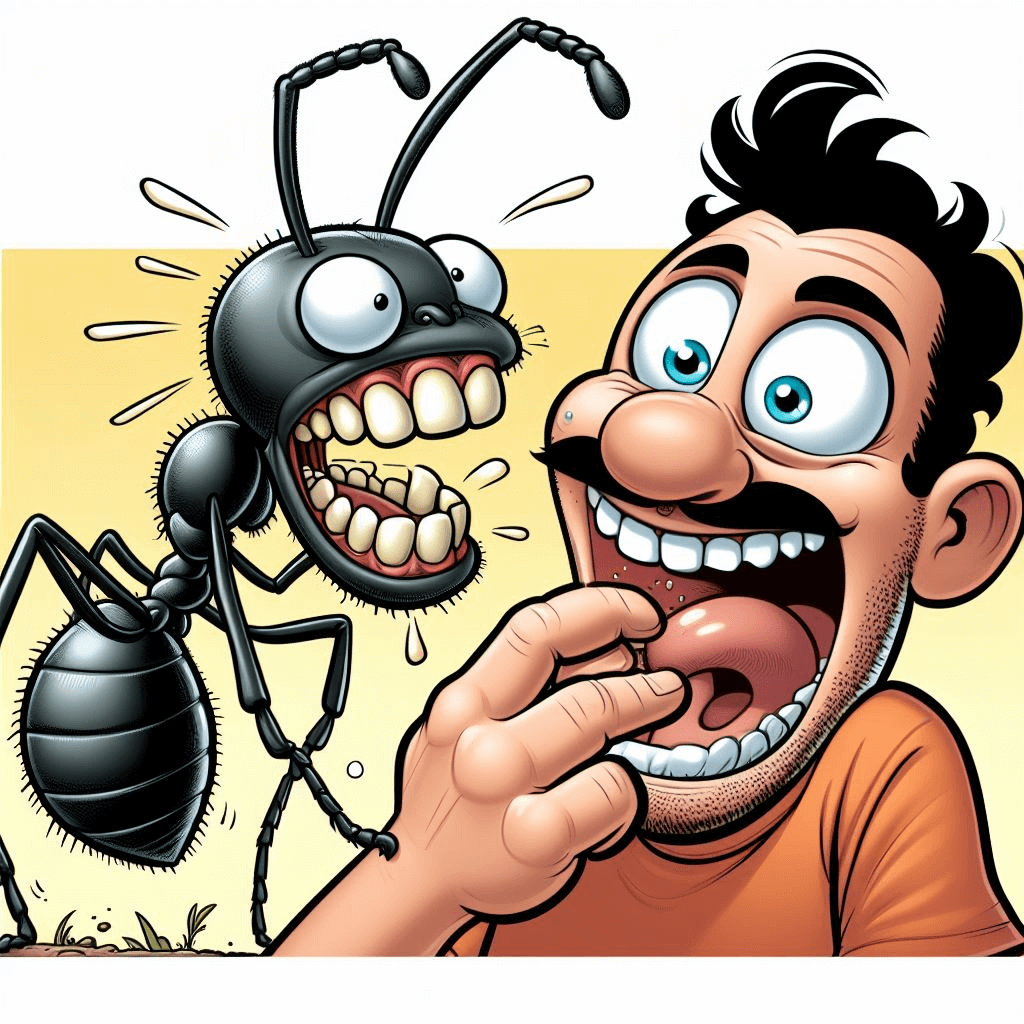Carpenter ants, often considered the esteemed architects of the insect world, are remarkable creatures known for their ability to create nests within wooden structures. While most ant species are a mere nuisance, carpenter ants can pose significant threats if left unchecked.
These insects are larger than your average ant and boast a sophisticated set of mandibles that allow them to bite with precision and vigor. Understanding their behavior and potential threats is essential in safeguarding wooden structures from their destructive tendencies.
Carpenter fire ants, scientifically designated as Camponotus spp., belong to the Formicidae family. They differ from termites, another notorious wood-invading creature, as they do not eat wood directly.
Instead, carpenter ants excavate tunnels within decaying or moist wood to build nests where they establish thriving colonies. These nests can be found both indoors and outdoors, making it crucial for homeowners to be aware of signs indicating a possible carpenter ant nest infestation.
Recognizing carpenter ants is relatively simple due to their distinctive physical features. They typically measure between 0.25 and 0.5 inches in length and exhibit varying shades of black or reddish-brown coloration.
Unlike other ant species that possess slender bodies, these sturdy insects sport a robust physique with segmented body parts. Understanding the behavior patterns of carpenter ants is paramount in preventing structural damage caused by their incessant nest-building activities.
When these industrious insects feel threatened, they resort to biting as a defense mechanism against perceived enemies or intruders that encroach upon their territories. Though not aggressive by nature, when provoked or cornered, multiple ants may combine forces to deliver painful bites using their powerful mandibles.
Comprehending the characteristics and behaviors of carpenter ants is vital for homeowners and property owners alike. Being mindful of their potential threats can help prevent the destruction of wooden structures and minimize the risk of carpenter ant bites.
By identifying key indicators of infestation, such as the presence of sawdust-like debris near wooden areas or rustling noises within walls, individuals can take prompt action to rid their properties of these pests. In the subsequent sections, we shall delve deeper into the intricacies of carpenter ants’ biting habits, discuss associated health risks, and explore preventive measures to mitigate infestation concerns.
Carpenter Ants’ Bite: Dispelling the Myths

Unraveling the Truth Behind Carpenter Ants’ Biting Habits
When it comes to carpenter ants, misconceptions often abound regarding their biting habits. Many people mistakenly believe that carpenter ants bite viciously and cause significant harm. However, it is important to distinguish between fact and fiction when discussing these intriguing insects.
Contrary to popular belief, carpenter ants are not naturally aggressive biters. They lack the venomous sting of some other insects like bees or wasps.
Carpenter ants primarily use their mandibles, or jaws, for chewing wood as they build nests within decaying trees or moist wood structures. Their primary focus is not to bite humans but rather to excavate tunnels, nest, and expand their colonies.
Differentiating Between Biting and Stinging Insects
It is crucial to properly differentiate between biting and stinging insects when discussing carpenter ants’ behavior. While mosquitoes, ticks, or even other ant species may rely on bites as a means of defense or acquiring food, this does not necessarily apply to carpenter ants.
Biting involves the use of mandibles to grip or chew on objects such as wood or prey. Carpenter ants employ this technique primarily for constructing their nests and defending themselves against potential threats.
On the other hand, stinging involves injecting venom into a target through a specialized structure like a stinger. Though certain species of ants possess stingers for self-defense against predators, this does not include carpenter ants.
Understanding these distinctions helps dispel myths surrounding carpenter ants’ aggression towards humans while highlighting their unique behaviors within their complex colony structures. Nonetheless, while it is rare for these insects to bite humans intentionally, instances may occur if they feel threatened or cornered in self-defense situations.
Anatomy of a Carpenter Ant’s Bite

Detailed description of carpenter ants’ mouthparts and mandibles
Carpenter ants, much like other ant species, possess a unique set of mouthparts that enable them to carry out various tasks. Their mandibles, which are hard and powerful jaws located on either side of their head, play a vital role in their ability to bite and defend themselves.
These mandibles are curved and sharp, resembling tiny scissors ready to snap shut at any moment. They are primarily used to cut through wood fibers when building nests or excavating tunnels.
How they use their jaws to bite and defend themselves
When carpenter ants feel threatened or encounter an obstacle in their path, they rely on their strong mandibles to bite as a defense mechanism. When biting, these worker ants apply significant force with their jaws, which can result in discomfort or pain for the bitten individual.
Although they prefer to use their biting ability for self-defense rather than attacking humans directly, if provoked or handled roughly, they may indeed nip at human skin. During a bite, carpenter ants grip the target area firmly between their mandibles and may also inject formic acid into the bite wound using the stinger located near the end of their abdomen.
This acid secretion serves as an additional deterrent against potential threats by causing irritation and discomfort at the bite site. While not all individuals will experience adverse reactions from carpenter ant bites due to varying levels of sensitivity among people, it is essential to note that repeated bites have the potential to cause more severe reactions.
It is important to remember that while carpenter ant bites can cause pain or discomfort similar to other insect bites, they do not pose a significant health risk unless an allergic reaction occurs. However, it is always recommended to take precautions after being bitten by carpenter ants by cleaning the affected area thoroughly with mild soap and water, applying antiseptic to prevent infection, and using ice or a cold compress to alleviate pain and reduce swelling.
Understanding Carpenter Ants’ Defensive Behavior
Exploring the Reasons Behind Carpenter Ants Resorting to Biting as a Defense Mechanism
Carpenter ants, like most creatures, have a natural instinct for self-defense. When they feel threatened or believe their colony is under attack, they resort to a defensive response, which can include biting. However, it’s important to note that carpenter ants don’t bite humans out of aggression or for sustenance; rather, they use their mandibles to protect themselves and their nests.
These insects have strong jaws designed to tear into wood and construct intricate tunnels, so when they bite, it can be quite uncomfortable for humans. One reason carpenter ants resort to biting is their territorial nature.
They are fiercely protective of their nests and will defend them against any perceived intruders. When disturbed or if an unknown presence invades their space—such as accidentally stumbling upon one of their colonies—they may interpret this as a threat and bite in an attempt to ward off the intruder.
Factors that May Trigger Aggressive Behavior in these Ants

Several factors can trigger aggressive behavior in carpenter ants, leading them to resort to biting as a defense mechanism. Firstly, if you unknowingly come across a carpenter ant colony while performing activities like gardening or home repairs near wooded areas or on tree branches or stumps, you might inadvertently disrupt their habitat. This sudden disturbance can cause the ants to feel threatened and provoke them into biting.
Additionally, individual carpenter ants may react aggressively if they perceive you as a potential source of harm. For instance, if you unintentionally block one of their foraging trails while walking outdoors or accidentally disturb one within your home by moving furniture around—it could lead them to react defensively by biting.
It’s worth noting that some species of carpenter ants are more aggressive than others. Certain larger colonies, particularly those established over a long period, tend to display more aggressive behavior when they sense any potential threat.
If you encounter carpenter ants in larger numbers, it’s best to exercise caution and avoid any actions that could provoke them. Overall, understanding the reasons behind carpenter ants resorting to biting as a defense mechanism and recognizing the factors that trigger their aggressive behavior can help individuals prevent unwanted encounters and ensure safer coexistence with these fascinating creatures.
The Pain Factor: How Painful Are Carpenter Ant Bites?

Comparing the pain level of carpenter ant bites with other insect bites/stings
When it comes to the pain caused by insect bites and stings, it’s essential to understand that different people may have varying responses. However, in general, carpenter ant bites are known to be relatively mild in terms of pain compared to some other biting or stinging insects. While their bite is certainly noticeable, many individuals describe the sensation as more of a mild irritation rather than intense pain.
If we were to compare carpenter ant bites with other insect bites and stings, such as those from wasps or bees, the difference in pain level becomes evident. Carpenter ants are not equipped with venomous stingers like some other species.
Their bite is primarily a defensive mechanism rather than an offensive one. This means that while it may be uncomfortable or cause a slight burning sensation for a short period, it is generally less painful than being stung by a bee or wasp.
Personal experiences shared by individuals who have been bitten by carpenter ants
To gain insight into the true nature of carpenter ant bites, let’s turn our attention to personal experiences shared by individuals who have encountered these insects firsthand. Many people who have been bitten by the carpenter ant colonies or ants describe the sensation as similar to a small pinch accompanied by a brief burning feeling. The intensity of these sensations varies from person to person and can also depend on factors such as skin sensitivity.
Interestingly, several individuals report that they initially mistook the bite for another insect’s sting due to its discomforting effect and initial reddening at the site. However, over time, they noticed that the symptoms subsided relatively quickly without any severe complications or long-lasting effects.
It is crucial to note that allergic reactions can occur in rare cases; therefore, anyone experiencing severe symptoms after a carpenter ant bite should seek medical advice. Ultimately, while carpenter ant bites may cause temporary discomfort and irritation, they generally fall on the milder end of the pain spectrum when compared to other insect bites or stings.
However, it is always important to exercise caution and take necessary precautions to prevent any potential harm from these pests. Note: If you are dealing with a significant carpenter ant infestation or have concerns about potential health risks associated with their bites, it is advisable to consult a pest control professional for guidance and assistance in getting rid of carpenter- ants effectively.
Health Risks Associated with Carpenter Ant Bites

Discussing potential health hazards caused by allergic reactions to ant bites
Carpenter ants, like many other insects, can cause allergic reactions in some individuals when they bite. For those who are hypersensitive or have a history of allergies, a carpenter ant bite can lead to itching, swelling, and redness around the affected area.
In severe cases, it may even trigger an anaphylactic reaction that requires immediate medical attention. It is essential for individuals prone to allergies or with a known sensitivity to insect bites or stings to take necessary precautions when encountering these insects.
Exploring secondary infections resulting from scratching or improper wound care
An important aspect of carpenter ant bites involves the potential risk of secondary infections that can arise if proper wound care is not observed. When bitten by a carpenter ant, the urge to scratch the affected area may be irresistible for some individuals due to discomfort or itchiness. However, excessive scratching can break the skin and introduce harmful bacteria into the wound, leading to infection.
It is crucial to refrain from scratching and instead clean the bite site gently with soap and water. Applying an antiseptic or antibiotic ointment, and covering it with a bandage will help prevent infection and promote healing.
Preventive Measures against Carpenter Ants’ Bites
Tips for minimizing encounters with carpenter ants in residential areas
To prevent carpenter ants from becoming unwelcome guests in your home, there are several proactive measures you can take. Firstly, eliminate potential food sources such as improperly stored food or spills that might attract these ants into your living space.
Additionally, seal any cracks or crevices where they might enter your home and ensure that windows and doors fit tightly. It is also advisable to keep trees and shrubs trimmed away from the house, as these can serve as bridges for carpenter ants to access your dwelling.
Effective methods for eliminating ant colonies near human dwellings

If you discover a carpenter ant colony near your home, swift action should be taken to prevent potential bites and minimize any structural damage they may cause. One effective method is using bait stations that contain insecticide specifically formulated for carpenter ants.
These bait stations can be strategically placed near their nests, encouraging the ants to carry the toxic substance back to their colony, effectively eradicating it. Alternatively, professional pest control services can be sought when dealing with large colonies or multiple colonies that require specialized treatment.
Interesting Facts about Carpenter Ants’ Behavior
Highlighting unique characteristics such as communication, nesting habits, and colony structure
Carpenter ants have a highly sophisticated system of communication within their colony. They utilize chemical signals called pheromones to transmit messages, guiding other ants towards food sources or warning them of potential threats. Additionally, these remarkable insects exhibit interesting nesting habits by excavating wood to build elaborate galleries within which they create interconnected chambers for different purposes.
Lesser-known trivia about these fascinating insects
Did you know that carpenter ants don’t actually consume wood? Unlike termites who feed on cellulose within wood, carpenter ants hollow out galleries in wooden structures purely for nesting purposes. Furthermore, while their bites can certainly be painful due to the powerful jaws they possess, carpenter ants primarily bite humans when defending themselves or their nests rather than seeking food.
Understanding these intriguing aspects of carpenter ant behavior adds depth to our knowledge and appreciation of these small yet remarkable creatures.
Conclusion
Despite the potential health risks associated with carpenter ant bites, it is important to remember that these incidents are relatively rare and can be prevented with proper precautions. By understanding the dangers posed by allergic reactions and the risk of secondary infections, individuals can take appropriate steps to protect themselves. Additionally, adopting preventive measures such as minimizing food sources and eliminating colonies near human dwellings can greatly reduce encounters with carpenter ants.
While carpenter ants’ behavior may intrigue us with their unique communication systems and nesting habits, it’s important to maintain a balance between fascination and ensuring our homes remain free from their presence. By appreciating the distinct characteristics of these insects and implementing effective methods for control when necessary, we can coexist peacefully with the natural world around us.
Keep Ants at Bay with D-Termination: Las Vegas’ Leading Pest Control Service!

If you’re dealing with ant problems, D-Termination is here to help. Our seasoned team specializes in deterring ants, revitalizing cleanliness, and maintaining the integrity of your space. Bid farewell to ants—opt for D-Termination for highly effective pest control today!
Reach out to us at 702-919-6310 or visit dtermination.com to schedule your ant control service and regain your space from these unwelcome pests.
Frequently Asked Questions:
A carpenter ant bite can cause minor pain and irritation, similar to a bee sting.
A carpenter ant bite on a human may result in redness, swelling, and discomfort.
Carpenter ants are not typically aggressive toward humans.
The fastest way to get rid of carpenter ants is to locate and treat their nest, often requiring professional pest control assistance.








